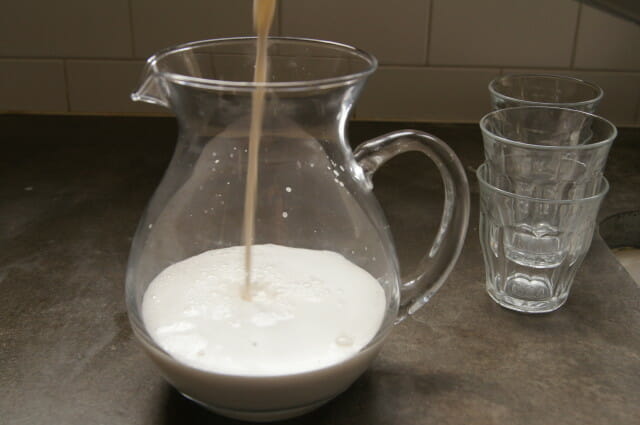When it comes to food trends, it’s sometimes hard to distinguish the health from the hype. A certain ingredient catches hold, often with very vocal cheerleaders, and it’s hard not to get swept up in the enthusiasm. Here I look at five of the hottest ingredients in the marketplace with my two cents on whether or not it’s too good to be true.
1. Almond Milk — The rise in almond milk sales over the past few years has been stratospheric. Ditto for other plant-based milks, such as hemp and coconut milk. I happen to be rather fond of almond milk, particularly when made in my very own kitchen. That said, there are a few things to keep in mind when it comes to stocking your pantry. For starters, homemade almond milk has very little calcium (most store-bought almond milk is calcium-fortified, so measures up relative to cow’s milk). In addition, almond milk, along with most plant-based milks, has relatively little protein, sometimes less than a gram per cup (compared to eight grams in cow’s milk and six in soy). Lastly, almond milk is often made with a lot more than almonds, notably added sugars, flavors, thickeners, and other additives.
My take: Read the list of ingredients to find the purest almond milk and look elsewhere for your protein. If you enjoy homemade almond milk, consider it a delicious and wholesome beverage rather than a rich source of calcium or protein.
2. Kale
Kale has been the “it girl” of the produce aisle for several years, and it doesn’t seem to be changing any time soon. Few trends are as welcome by nutrition professionals as this one. It’s an enormously nourishing vegetable, delivering fiber, folic acids, protein, and host of other nutrients. Is there a downside? Possibly. A study at Oregon State University found very high intakes of cruciferous vegetables, such as kale, can interfere with thyroid hormones and lead to hypothyroidism.
My take: Don’t panic. Concern about too much kale is just a reminder to include variety in your diet. Yes, kale is good for you, but getting micro-focused on a single food means we miss out on the rest of what’s colorful, flavorful, and nutritious in the produce aisle. Have your kale, but don’t forget about the carrots, squash, peppers, onions, cabbage, avocados, sweet potatoes, herbs, fennel, and tomatoes, too.
It’s the age of the tiny seed; chia, flax, and hemp are all the rage. Hemp seeds seem particularly fashionable of late, and for good reason. They’re little nuggets of nutrition that add texture and flavor to food. Two tablespoons pack 5 grams of protein, vitamin E, and a nice dose of Omega-3 fats, which most of us could use a lot more of, all at 90 calories.
My take: Try it. Adding a spoonful of hemp seeds to your oatmeal, smoothie, or lunch salad appears to have little downside. And be sure to experiment with other tiny seeds, too — chia, sesame, and flax to be exact. I’m a big believer in variety.
My take: If you enjoy boba tea, consider it a treat and enjoy it occasionally. When you do drink it, share, since the portion is often a large serving. Also, look for decaf boba for your kids and keep it out of the hands of the littlest ones in your house.
5. Coconut Oil — Coconut seems to be the darling of the marketplace these days, showing up in all its various forms, from coconut flour to coconut sugar. For the purposes of this post, let’s stick with coconut oil, a flavorful fat that, like butter, is solid at room temperature. There’s no doubt that this aromatic oil has its merits in cooking. It does a bang up job in a batch of popcorn and is brilliant in a loaf of banana bread. However, it’s a little too soon to peg coconut oil as the cooking cure-all many people purport it to be. The research underway about its potential health benefits is exciting, but it’s too soon to draw firm conclusions as to whether it truly does raise metabolism, protect against Alzheimer’s Disease, or any of the other common claims. What we do know is that coconut oil is a highly saturated fat, the type of fat that raises LDL (“bad”) cholesterol. At the same time, some of the fat in coconut oil is of a type known to raise HDL (“good”) cholesterol as well. Confusing, I know. And like all fats, coconut oil is concentrated in calories, about 120 per tablespoon.
My take? The jury is still out on coconut oil and its healthy upsides. For now, enjoy it in moderation, but don’t ditch the olive oil as your kitchen staple. When you do buy coconut oil, look for cold pressed virgin coconut oil, since it’s processed without chemicals or heat.
What’s your take on some of today’s trendy ingredients?
P.S. You might want to check out Part Two of this series for my thoughts on five more trendy foods.
P.P.S. Gratitude to my intern, Courtney Woo, a registered dietitian-in-training, for the research that went into this post.
